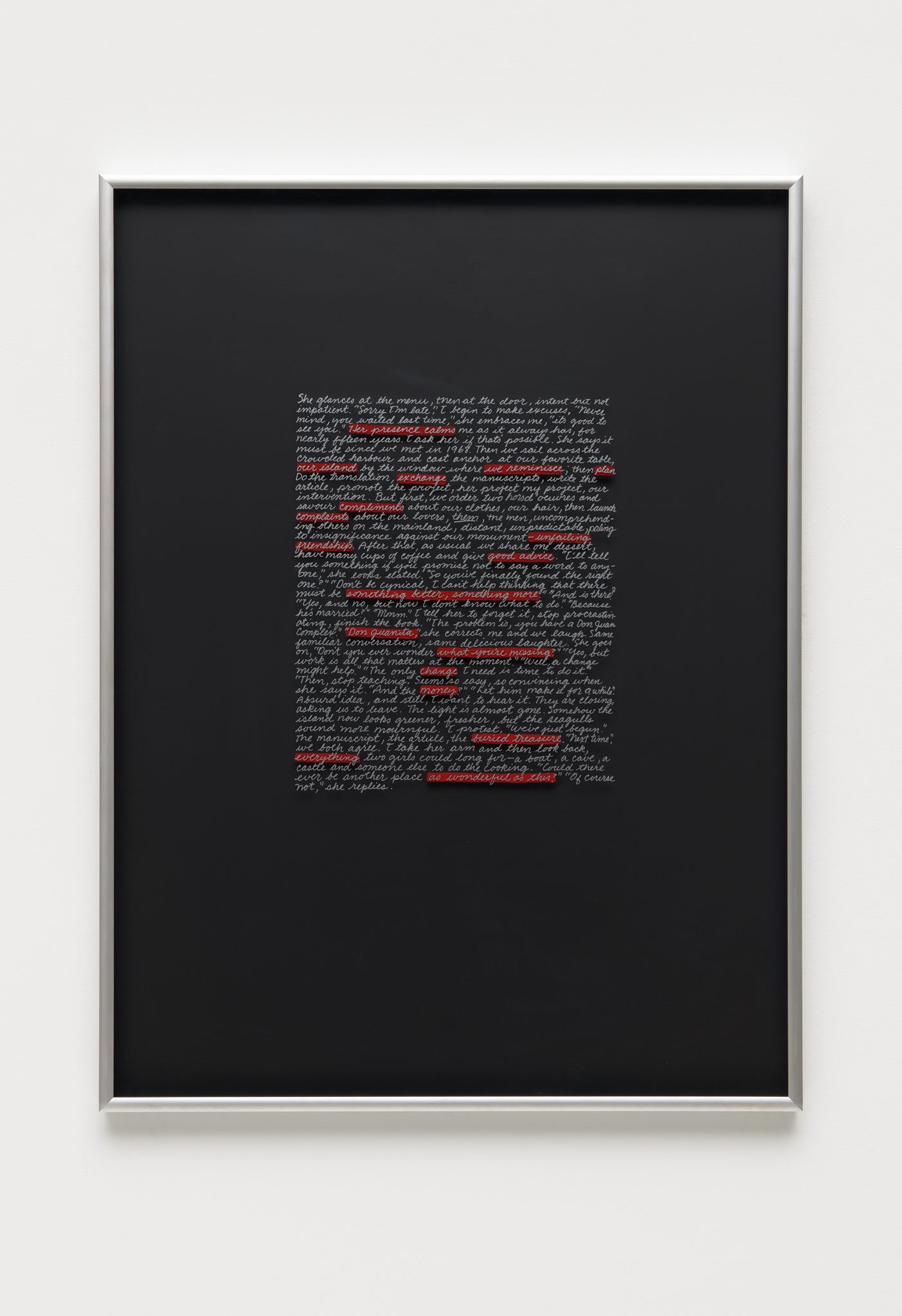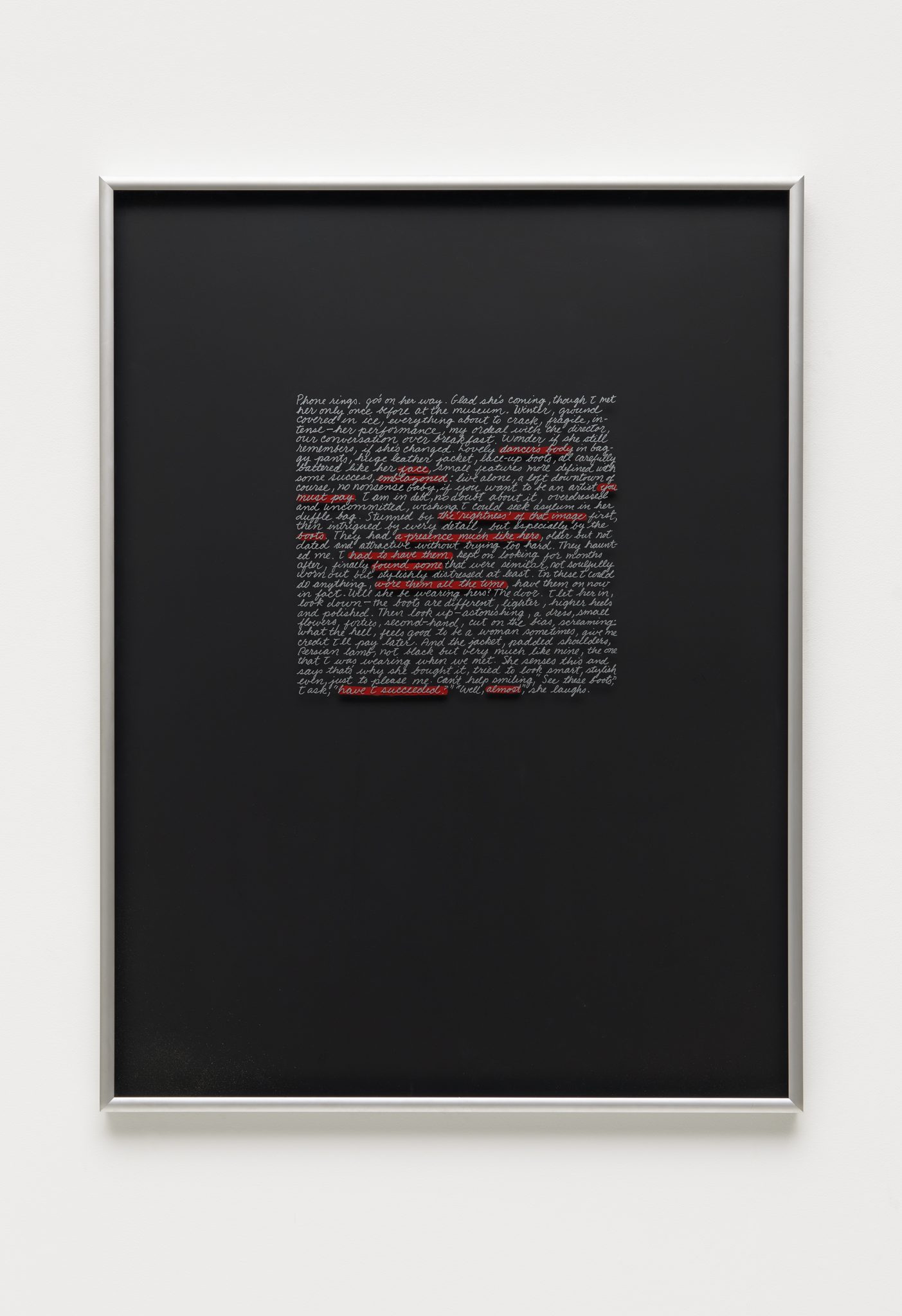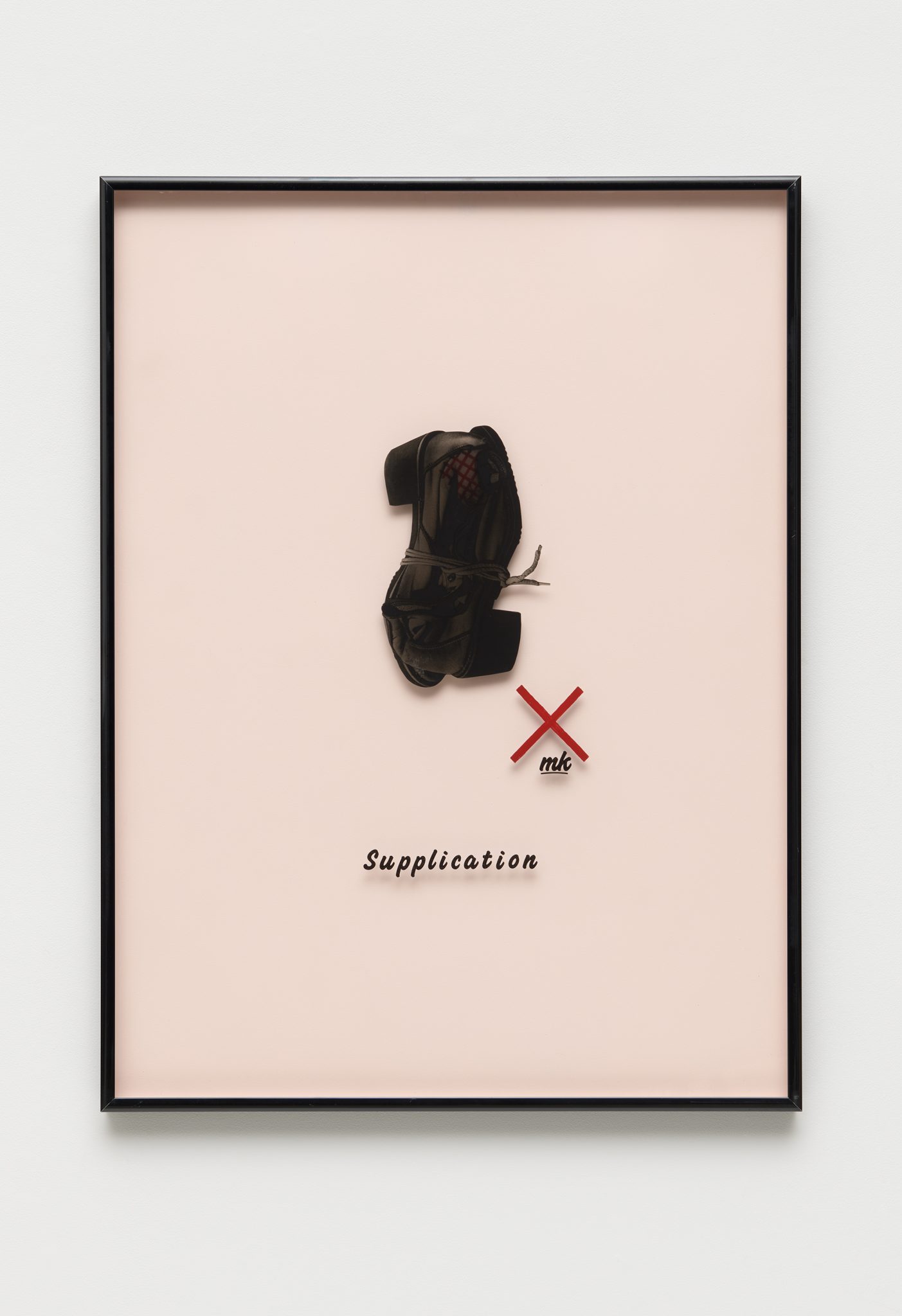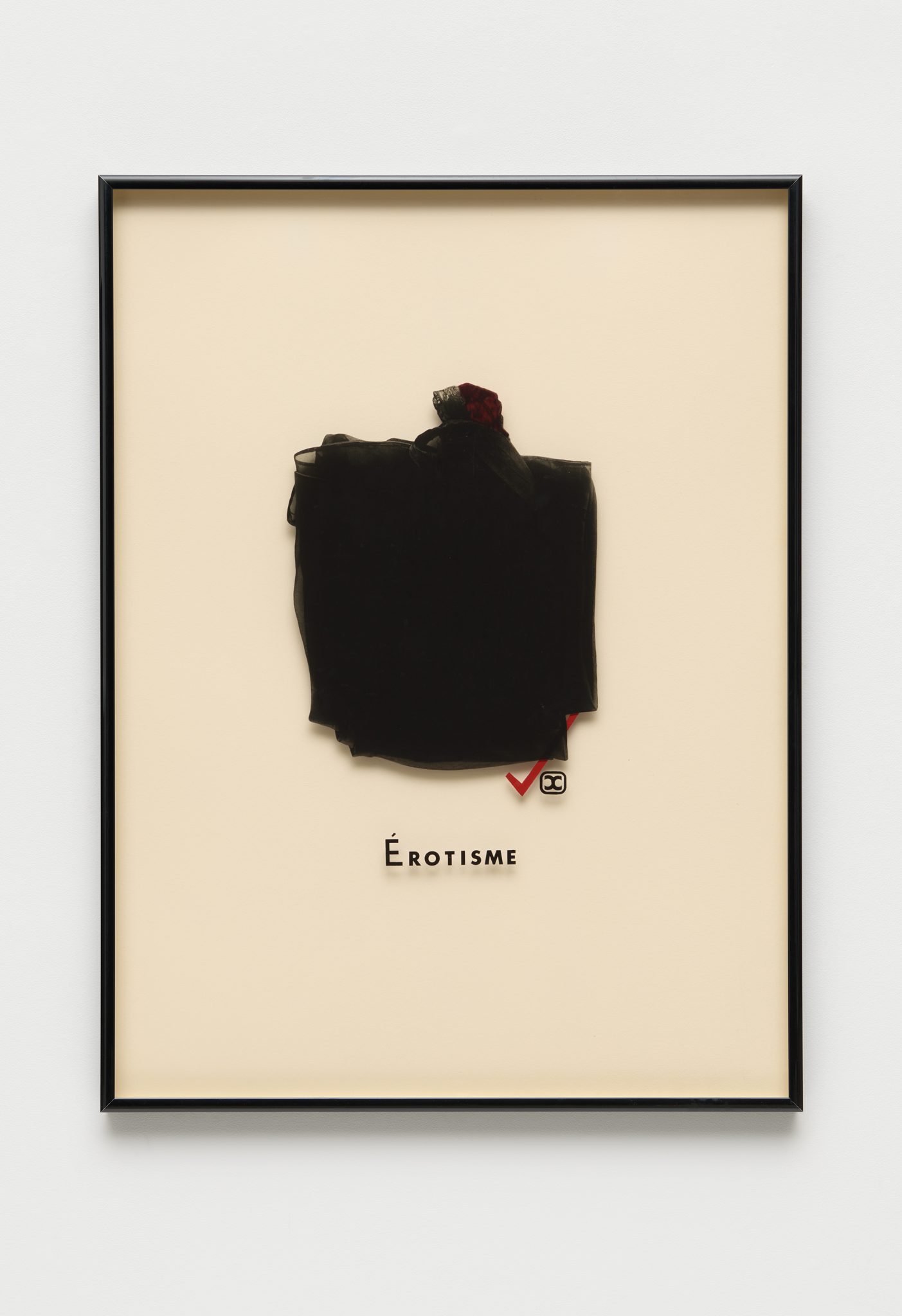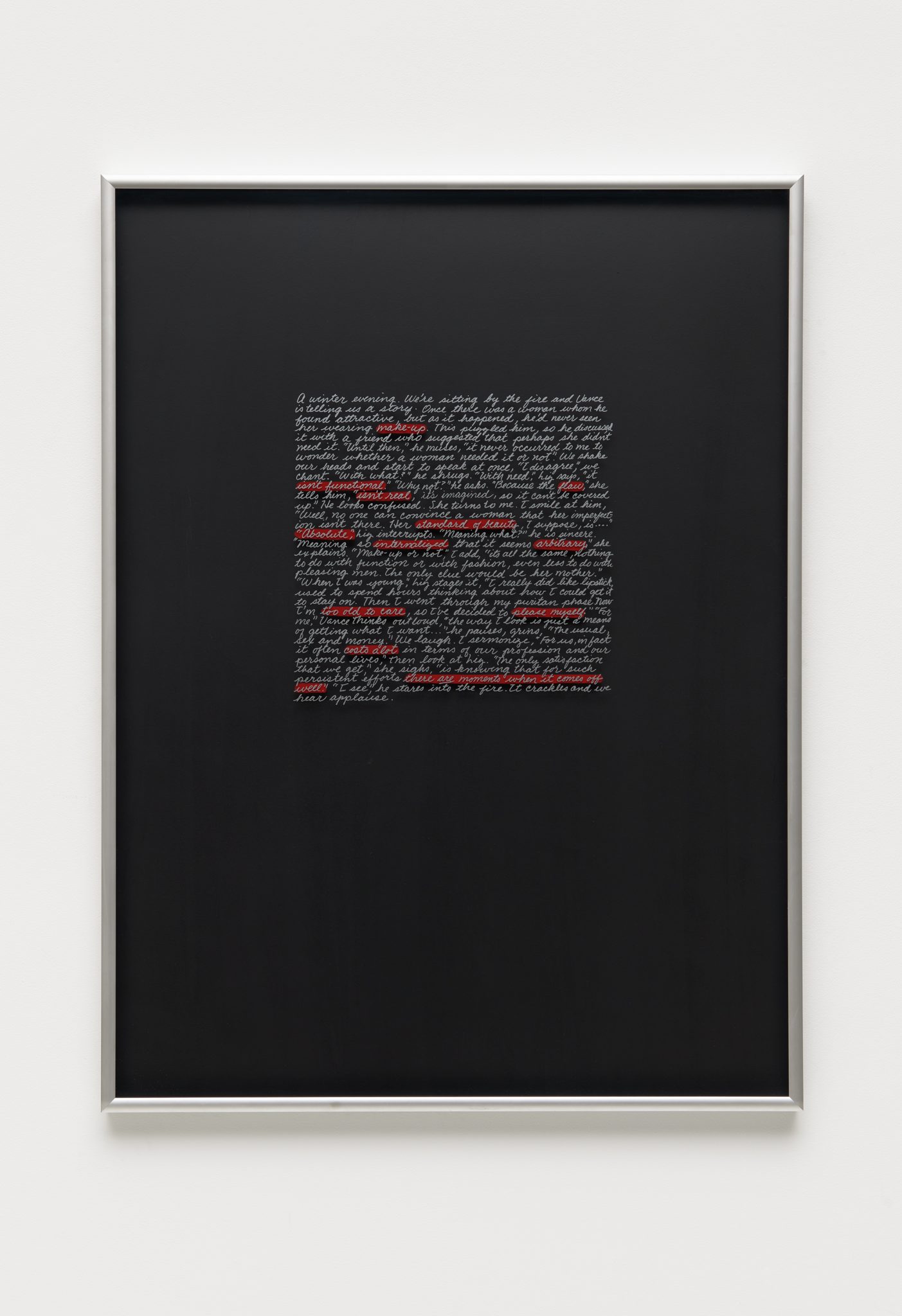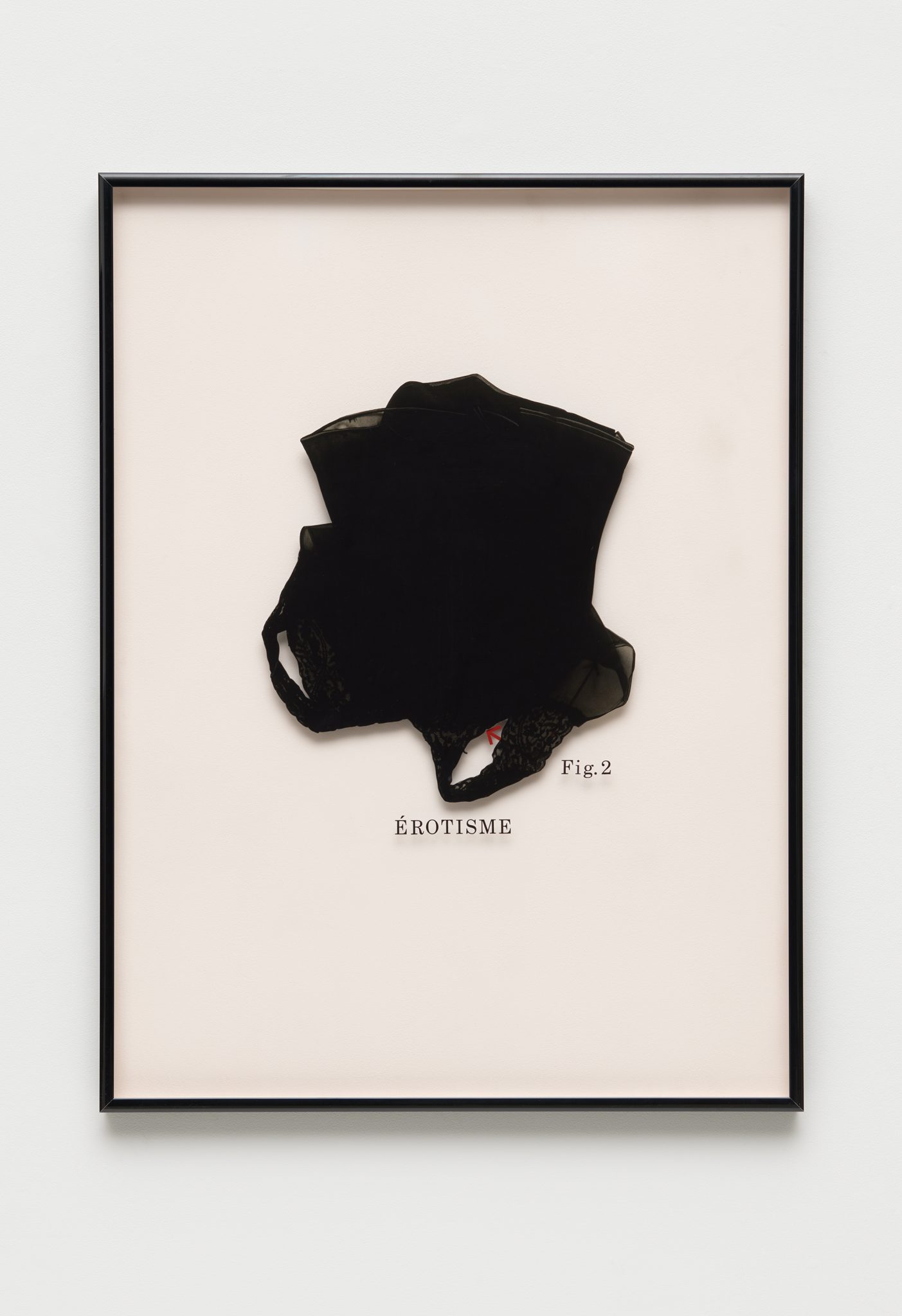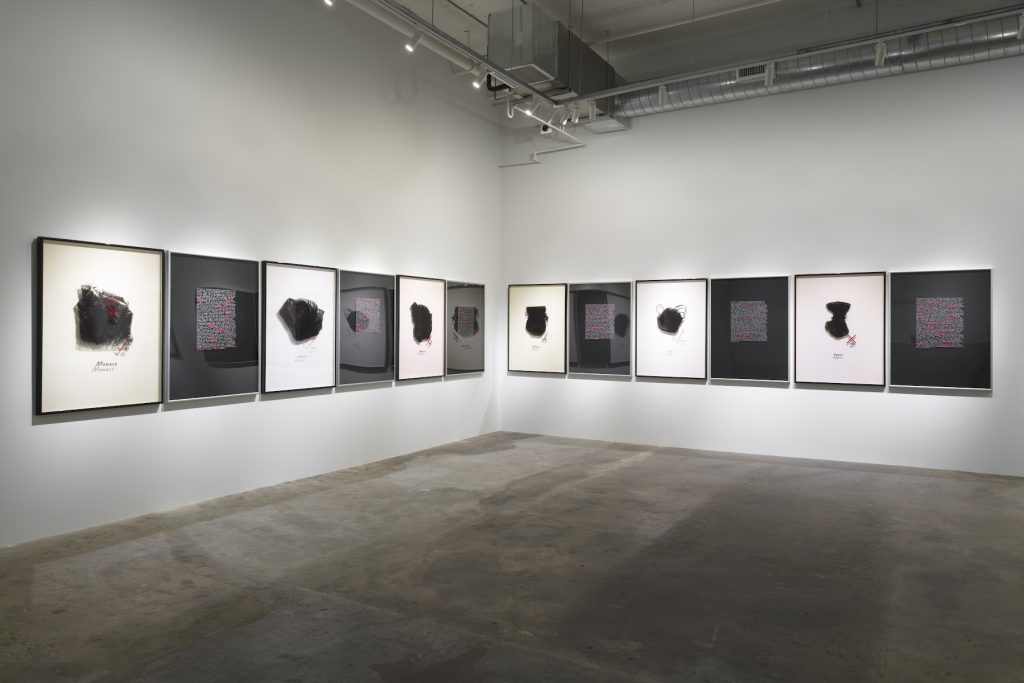

Opening Reception: September 3, 4 – 6PM
Vielmetter Los Angeles is thrilled to announce Mary Kelly: Corpus, an exhibition of Kelly’s ambitious 1984-85 installation, originally made as the first part of a larger project titled Interim. This will be the first complete installation of Corpus, including all thirty panels, in the United States since 1990 when the entire Interim project was exhibited at the New Museum to broad critical acclaim. Kelly is one of the most influential feminists and conceptual artists working today, and our exhibition marks a rare occasion to view her iconic work of the 1980s in its entirety.
Photo credit: Jeff McLane (installation views)
Interim marked a progressive step in Kelly’s conceptual, feminist practice. A project in four parts (Corpus, Pecunia, Potestas, and Historia), the exhibition explored the space between the social construction of women and how they experience themselves in relationship to ideas about femininity found in fashion, medicine, fantasy/fiction, the family, and media. The work engages a humorous approach to this conceptual material and to the femme experience itself. It allows the viewer to laugh at her anxieties about aging, her desire for power in a society that will only grant her power under very specific conditions, and the tension between constructing herself and how she is constructed and construed by others.
“Interim, Part I: Corpus,” 1984-1985
Laminated photo positive, silkscreen, acrylic on plexiglas
30 panels: 48" H x 36" W x 2" D each
Inventory #KEL101
Courtesy of the artist, Vielmetter Los Angeles, and Mitchell-Innes & Nash, New York
Photo credit: Brica Wilcox

“Interim, Part I: Corpus,” 1984-1985
Laminated photo positive, silkscreen, acrylic on plexiglas
30 panels: 48" H x 36" W x 2" D each
Inventory #KEL101
Courtesy of the artist, Vielmetter Los Angeles, and Mitchell-Innes & Nash, New York
Photo credit: Brica Wilcox
“Interim, Part I: Corpus,” 1984-1985
Laminated photo positive, silkscreen, acrylic on plexiglas
30 panels: 48" H x 36" W x 2" D each
Inventory #KEL101
Courtesy of the artist, Vielmetter Los Angeles, and Mitchell-Innes & Nash, New York
Photo credit: Brica Wilcox
“Interim, Part I: Corpus,” 1984-1985
Laminated photo positive, silkscreen, acrylic on plexiglas
30 panels: 48" H x 36" W x 2" D each
Inventory #KEL101
Courtesy of the artist, Vielmetter Los Angeles, and Mitchell-Innes & Nash, New York
Photo credit: Brica Wilcox
“Interim, Part I: Corpus,” 1984-1985
Laminated photo positive, silkscreen, acrylic on plexiglas
30 panels: 48" H x 36" W x 2" D each
Inventory #KEL101
Courtesy of the artist, Vielmetter Los Angeles, and Mitchell-Innes & Nash, New York
Photo credit: Brica Wilcox
“Interim, Part I: Corpus,” 1984-1985
Laminated photo positive, silkscreen, acrylic on plexiglas
30 panels: 48" H x 36" W x 2" D each
Inventory #KEL101
Courtesy of the artist, Vielmetter Los Angeles, and Mitchell-Innes & Nash, New York
Photo credit: Brica Wilcox
“Interim, Part I: Corpus,” 1984-1985
Laminated photo positive, silkscreen, acrylic on plexiglas
30 panels: 48" H x 36" W x 2" D each
Inventory #KEL101
Courtesy of the artist, Vielmetter Los Angeles, and Mitchell-Innes & Nash, New York
Photo credit: Brica Wilcox
“Interim, Part I: Corpus,” 1984-1985
Laminated photo positive, silkscreen, acrylic on plexiglas
30 panels: 48" H x 36" W x 2" D each
Inventory #KEL101
Courtesy of the artist, Vielmetter Los Angeles, and Mitchell-Innes & Nash, New York
Photo credit: Brica Wilcox
Visually arresting and narratively absorbing, Interim Part I: Corpus features five groups of three pairs of panels that mimic the scale of advertising images in bus kiosks. Each pair contains one panel, a photo laminate depicting an evocative item from Kelly’s wardrobe (a leather bucket bag, leather jacket, silk dress, lace up boots, and a lacy nightie) and a second panel of block text silkscreened in silver with painted red highlights. The confessional-style prose conveys women’s experiences at a period in life when anxieties about aging, remaining desirable, increasing one’s career or social success, and being the right kind of woman (before it’s too late) come to play. Each successive text becomes more absurd, resisting a literal psychological reading. Corpus examines the socially inscribed shift in what it means to be seen as a woman, from the visibility of youth to the invisibility of age. Each group of six panels is named after one of the five passionate attitudes that psychiatrist Jean-Martin Charcot attributed to hysterical women in the late-nineteenth century: Extase, Menacé, Supplication, Érotisme and Appel, poses that are continually replayed in media images today.
“Interim, Part I: Corpus,” 1984-1985
Laminated photo positive, silkscreen, acrylic on plexiglas
30 panels: 48" H x 36" W x 2" D each
Inventory #KEL101
Courtesy of the artist, Vielmetter Los Angeles, and Mitchell-Innes & Nash, New York
Photo credit: Brica Wilcox

“Interim, Part I: Corpus,” 1984-1985
Laminated photo positive, silkscreen, acrylic on plexiglas
30 panels: 48" H x 36" W x 2" D each
Inventory #KEL101
Courtesy of the artist, Vielmetter Los Angeles, and Mitchell-Innes & Nash, New York
Photo credit: Brica Wilcox
“Interim, Part I: Corpus,” 1984-1985
Laminated photo positive, silkscreen, acrylic on plexiglas
30 panels: 48" H x 36" W x 2" D each
Inventory #KEL101
Courtesy of the artist, Vielmetter Los Angeles, and Mitchell-Innes & Nash, New York
Photo credit: Brica Wilcox
“Interim, Part I: Corpus,” 1984-1985
Laminated photo positive, silkscreen, acrylic on plexiglas
30 panels: 48" H x 36" W x 2" D each
Inventory #KEL101
Courtesy of the artist, Vielmetter Los Angeles, and Mitchell-Innes & Nash, New York
Photo credit: Brica Wilcox
“Interim, Part I: Corpus,” 1984-1985
Laminated photo positive, silkscreen, acrylic on plexiglas
30 panels: 48" H x 36" W x 2" D each
Inventory #KEL101
Courtesy of the artist, Vielmetter Los Angeles, and Mitchell-Innes & Nash, New York
Photo credit: Brica Wilcox
“Interim, Part I: Corpus,” 1984-1985
Laminated photo positive, silkscreen, acrylic on plexiglas
30 panels: 48" H x 36" W x 2" D each
Inventory #KEL101
Courtesy of the artist, Vielmetter Los Angeles, and Mitchell-Innes & Nash, New York
Photo credit: Brica Wilcox
“Interim, Part I: Corpus,” 1984-1985
Laminated photo positive, silkscreen, acrylic on plexiglas
30 panels: 48" H x 36" W x 2" D each
Inventory #KEL101
Courtesy of the artist, Vielmetter Los Angeles, and Mitchell-Innes & Nash, New York
Photo credit: Brica Wilcox
“Interim, Part I: Corpus,” 1984-1985
Laminated photo positive, silkscreen, acrylic on plexiglas
30 panels: 48" H x 36" W x 2" D each
Inventory #KEL101
Courtesy of the artist, Vielmetter Los Angeles, and Mitchell-Innes & Nash, New York
Photo credit: Brica Wilcox
Following Kelly’s iconic Post-Partum Document, Interim, and Corpus in particular, make an emphatic turn to the construction of feminine identity outside of the reproductive paradigm. Critically, while the work is titled for the body, Kelly does not represent the woman’s body in Corpus. In its place are garments that make up a uniform and signify, even today, a specific self-image: serious, stylish, tough, and sensual. Kelly has said that one of her goals in Corpus was to “create a space for the woman, or the spectator in the position of the woman, to send herself up, like the joke. A space where she could laugh at herself and gain a certain distance from that hyperbolic femininity […] Miming the hysteric in Corpus seemed to be a way of releasing the woman from that moment of narcissistic identification that pertains to sexual difference.”(1) Through its use of narrative, the work emphasizes listening to women rather than looking at them, and discovering the pleasure and erotic charge found in each other’s company.
–
(1) Interview with Mary Kelly in Art Monthly http://www.artmonthly.co.uk/magazine/site/article/mary-kelly-interviewed-by-maria-walsh-may-2011
“Interim, Part I: Corpus,” 1984-1985
Laminated photo positive, silkscreen, acrylic on plexiglas
30 panels: 48" H x 36" W x 2" D each
Inventory #KEL101
Courtesy of the artist, Vielmetter Los Angeles, and Mitchell-Innes & Nash, New York
Photo credit: Brica Wilcox

“Interim, Part I: Corpus,” 1984-1985
Laminated photo positive, silkscreen, acrylic on plexiglas
30 panels: 48" H x 36" W x 2" D each
Inventory #KEL101
Courtesy of the artist, Vielmetter Los Angeles, and Mitchell-Innes & Nash, New York
Photo credit: Brica Wilcox
“Interim, Part I: Corpus,” 1984-1985
Laminated photo positive, silkscreen, acrylic on plexiglas
30 panels: 48" H x 36" W x 2" D each
Inventory #KEL101
Courtesy of the artist, Vielmetter Los Angeles, and Mitchell-Innes & Nash, New York
Photo credit: Brica Wilcox
“Interim, Part I: Corpus,” 1984-1985
Laminated photo positive, silkscreen, acrylic on plexiglas
30 panels: 48" H x 36" W x 2" D each
Inventory #KEL101
Courtesy of the artist, Vielmetter Los Angeles, and Mitchell-Innes & Nash, New York
Photo credit: Brica Wilcox
“Interim, Part I: Corpus,” 1984-1985
Laminated photo positive, silkscreen, acrylic on plexiglas
30 panels: 48" H x 36" W x 2" D each
Inventory #KEL101
Courtesy of the artist, Vielmetter Los Angeles, and Mitchell-Innes & Nash, New York
Photo credit: Brica Wilcox
“Interim, Part I: Corpus,” 1984-1985
Laminated photo positive, silkscreen, acrylic on plexiglas
30 panels: 48" H x 36" W x 2" D each
Inventory #KEL101
Courtesy of the artist, Vielmetter Los Angeles, and Mitchell-Innes & Nash, New York
Photo credit: Brica Wilcox
“Interim, Part I: Corpus,” 1984-1985
Laminated photo positive, silkscreen, acrylic on plexiglas
30 panels: 48" H x 36" W x 2" D each
Inventory #KEL101
Courtesy of the artist, Vielmetter Los Angeles, and Mitchell-Innes & Nash, New York
Photo credit: Brica Wilcox
“Interim, Part I: Corpus,” 1984-1985
Laminated photo positive, silkscreen, acrylic on plexiglas
30 panels: 48" H x 36" W x 2" D each
Inventory #KEL101
Courtesy of the artist, Vielmetter Los Angeles, and Mitchell-Innes & Nash, New York
Photo credit: Brica Wilcox
In the more than four decades since Post-Partum Document was first made and exhibited, the work has become such a fixture of Art Historical surveys that it can be difficult for contemporary viewers to access just how radical this work was when first presented in the 1970s and 80s. The deeply personal work, rendered in the aesthetic terms of highly analytical conceptual art, startled the art establishment and reverberated across disciplines. For many artists and academics, it was their first exposure to the psychoanalytic theories of Lacan and ideas that now have become taken for granted in our understanding of gender as a socially constructed performance, something fluid and mediated, not determined by biological sex. These ideas, and the possibilities they offered through artists like Kelly, ignited a fury of intellectual and artistic activity that continues to inform serious writing and analysis in the humanities, social sciences, and the arts.
“Interim, Part I: Corpus,” 1984-1985
Laminated photo positive, silkscreen, acrylic on plexiglas
30 panels: 48" H x 36" W x 2" D each
Inventory #KEL101
Courtesy of the artist, Vielmetter Los Angeles, and Mitchell-Innes & Nash, New York
Photo credit: Brica Wilcox

“Interim, Part I: Corpus,” 1984-1985
Laminated photo positive, silkscreen, acrylic on plexiglas
30 panels: 48" H x 36" W x 2" D each
Inventory #KEL101
Courtesy of the artist, Vielmetter Los Angeles, and Mitchell-Innes & Nash, New York
Photo credit: Brica Wilcox
“Interim, Part I: Corpus,” 1984-1985
Laminated photo positive, silkscreen, acrylic on plexiglas
30 panels: 48" H x 36" W x 2" D each
Inventory #KEL101
Courtesy of the artist, Vielmetter Los Angeles, and Mitchell-Innes & Nash, New York
Photo credit: Brica Wilcox
“Interim, Part I: Corpus,” 1984-1985
Laminated photo positive, silkscreen, acrylic on plexiglas
30 panels: 48" H x 36" W x 2" D each
Inventory #KEL101
Courtesy of the artist, Vielmetter Los Angeles, and Mitchell-Innes & Nash, New York
Photo credit: Brica Wilcox
“Interim, Part I: Corpus,” 1984-1985
Laminated photo positive, silkscreen, acrylic on plexiglas
30 panels: 48" H x 36" W x 2" D each
Inventory #KEL101
Courtesy of the artist, Vielmetter Los Angeles, and Mitchell-Innes & Nash, New York
Photo credit: Brica Wilcox
“Interim, Part I: Corpus,” 1984-1985
Laminated photo positive, silkscreen, acrylic on plexiglas
30 panels: 48" H x 36" W x 2" D each
Inventory #KEL101
Courtesy of the artist, Vielmetter Los Angeles, and Mitchell-Innes & Nash, New York
Photo credit: Brica Wilcox
“Interim, Part I: Corpus,” 1984-1985
Laminated photo positive, silkscreen, acrylic on plexiglas
30 panels: 48" H x 36" W x 2" D each
Inventory #KEL101
Courtesy of the artist, Vielmetter Los Angeles, and Mitchell-Innes & Nash, New York
Photo credit: Brica Wilcox
“Interim, Part I: Corpus,” 1984-1985
Laminated photo positive, silkscreen, acrylic on plexiglas
30 panels: 48" H x 36" W x 2" D each
Inventory #KEL101
Courtesy of the artist, Vielmetter Los Angeles, and Mitchell-Innes & Nash, New York
Photo credit: Brica Wilcox
Through exhibitions of Post-Partum Document in 1976 at the Institute for Contemporary Art, London and in 1984 at the Yale Center for British Art, New Haven, CT, Kelly became an integral part of a group of artists and critics concerned with women’s issues, gay rights, conceptual art, and post-modernism including Hans Haacke, Dan Graham, Maria Nordman, Jenny Holzer, Lucy Lippard, Barbara Kruger, Sherri Levine, Louise Lawler, Douglas Crimp, Craig Owens, Rosalyn Deutsch, and Jane Weinstock. Intersecting with the “Pictures Generation” artists, Kelly’s Corpus similarly appropriated media images as a strategy of critique. At the time, the art world was still very engaged in classifying artists by “movement” and the stakes of one’s intellectual and creative production were high. Philosophical debates about the concerns of art were a defining part of studio and social life, and artists, writers, and others would often follow each other around the city and the world eager to see how new ideas would develop in each other’s work.
“Interim, Part I: Corpus,” 1984-1985
Laminated photo positive, silkscreen, acrylic on plexiglas
30 panels: 48" H x 36" W x 2" D each
Inventory #KEL101
Courtesy of the artist, Vielmetter Los Angeles, and Mitchell-Innes & Nash, New York
Photo credit: Brica Wilcox

“Interim, Part I: Corpus,” 1984-1985
Laminated photo positive, silkscreen, acrylic on plexiglas
30 panels: 48" H x 36" W x 2" D each
Inventory #KEL101
Courtesy of the artist, Vielmetter Los Angeles, and Mitchell-Innes & Nash, New York
Photo credit: Brica Wilcox
“Interim, Part I: Corpus,” 1984-1985
Laminated photo positive, silkscreen, acrylic on plexiglas
30 panels: 48" H x 36" W x 2" D each
Inventory #KEL101
Courtesy of the artist, Vielmetter Los Angeles, and Mitchell-Innes & Nash, New York
Photo credit: Brica Wilcox
“Interim, Part I: Corpus,” 1984-1985
Laminated photo positive, silkscreen, acrylic on plexiglas
30 panels: 48" H x 36" W x 2" D each
Inventory #KEL101
Courtesy of the artist, Vielmetter Los Angeles, and Mitchell-Innes & Nash, New York
Photo credit: Brica Wilcox
“Interim, Part I: Corpus,” 1984-1985
Laminated photo positive, silkscreen, acrylic on plexiglas
30 panels: 48" H x 36" W x 2" D each
Inventory #KEL101
Courtesy of the artist, Vielmetter Los Angeles, and Mitchell-Innes & Nash, New York
Photo credit: Brica Wilcox
“Interim, Part I: Corpus,” 1984-1985
Laminated photo positive, silkscreen, acrylic on plexiglas
30 panels: 48" H x 36" W x 2" D each
Inventory #KEL101
Courtesy of the artist, Vielmetter Los Angeles, and Mitchell-Innes & Nash, New York
Photo credit: Brica Wilcox
“Interim, Part I: Corpus,” 1984-1985
Laminated photo positive, silkscreen, acrylic on plexiglas
30 panels: 48" H x 36" W x 2" D each
Inventory #KEL101
Courtesy of the artist, Vielmetter Los Angeles, and Mitchell-Innes & Nash, New York
Photo credit: Brica Wilcox
Seen from the perspective of 2022, Corpus is vital not just as a metonym for the heady and human debates of second-wave feminism in the 1980s downtown New York art scene, but also because the questions at its core could not be more timely: How do we know who we are? How is our subjectivity—what we believe ourselves to be—constituted in and by the social order? And who is doing the constituting?
Bio
Mary Kelly (b. 1941) is one of the most influential American conceptual artists. Her work is currently on view in “The Condition of Being Addressable,” curated by Legacy Russell, at the ICALA. She has had significant solo exhibitions at the Whitworth Gallery, Manchester, UK; the Santa Monica Museum, Santa Monica, CA; the New Museum of Contemporary Art, New York, NY; the Generali Foundation, Vienna, AT; the Moderna Museet, Stockholm, SE; the Center for Contemporary Art, Ujadowski Castle, Warsaw, PL; and the Institute for Contemporary Art, London, UK. Recent noteworthy group exhibitions include “Theater of Operations: The Gulf Wars 1991-2011,” MoMA PS1, Long Island City, NY; “Take It or Leave It: Institution, Image Ideology,” Hammer Museum, Los Angeles, CA; “Women and Work,” Tate Britain, London, UK; “Ends of the Earth: Land Art to 1974.” Museum of Contemporary Art, Los Angeles, CA; “This Will Have Been: Art, Love and Politics in the 1980’s,” Museum of Contemporary Art, Chicago, IL; “Revolutions — Forms That Turn,” 2008 Biennale of Sydney, AU; “Wack! Art and the Feminist Revolution,” Museum of Contemporary Art, Los Angeles, CA; “Documenta 12,” Kassel, DE; and “Whitney Biennial 2014,” Whitney Museum of American Art, New York, NY.


























